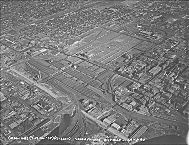| Entries |
| N |
|
New City
|
 Community Area 61, 5 miles SW of the Loop. University of Chicago sociologists established boundaries for
community areas
in the 1920s and subsequently named a large section of land around the Chicago stockyards New City. Yet the area designated as New City has never represented a single community.
Community Area 61, 5 miles SW of the Loop. University of Chicago sociologists established boundaries for
community areas
in the 1920s and subsequently named a large section of land around the Chicago stockyards New City. Yet the area designated as New City has never represented a single community.
The Union Stock Yard opened for business on December 25, 1865, outside Chicago's city boundaries in Lake Township. In 1889, this area was annexed into Chicago. In its 105-year history, the stockyards and adjacent meatpacking district represented the key overlapping institutions for the diverse communities of New City. Although most residents worked for the stockyards or its auxiliary industries, these residents socialized in different spatial areas. Class and ethnic differences defined this area not as New City but by other separate designations; the most enduring of these appellations are the Back of the Yards and Canaryville.

|
Settlers of Canaryville, to the east of the stockyards, worked as clerks, cattle buyers, and managers. This neighborhood began as a middle-class and largely German-based Protestant community including the family of Gustavus Swift, one of the founders of the meatpacking empire. Soon after the establishment of Canaryville, lower-middle-class Irish Roman Catholics moved into the neighborhood. While this neighborhood has also become more diverse over time, its residents still earn a higher average income than the other sections of New City.

|

|
| New City (CA 61) | |||||
| Year |
Total
(and by category) |
Foreign Born | Native with foreign parentage | Males per 100 females | |
| 1930 | 87,103 | 29.3% | 49.8% | 110 | |
| 84,866 | White (97.4%) | ||||
| 79 | Negro (0.1%) | ||||
| 2,158 | Other (2.5%) | ||||
| 1960 | 67,428 | 14.0% | 31.5% | 99 | |
| 67,172 | White (99.6%) | ||||
| 166 | Negro (0.2%) | ||||
| 90 | Other races (0.1%) | ||||
| 1990 | 53,226 | 20.7% | — | 100 | |
| 16,937 | White (31.8%) | ||||
| 22,245 | Black (41.8%) | ||||
| 114 | American Indian (0.2%) | ||||
| 186 | Asian/Pacific Islander (0.3%) | ||||
| 13,744 | Other race (25.8%) | ||||
| 20,906 | Hispanic Origin* (39.3%) | ||||
| 2000 | 51,721 | 29.5% | — | 102 | |
| 17,877 | White alone (34.6%) | ||||
| 18,489 | Black or African American alone (35.7%) | ||||
| 276 | American Indian and Alaska Native alone (0.5%) | ||||
| 175 | Asian alone (0.3%) | ||||
| 42 | Native Hawaiian and Other Pacific Islander alone (0.1%) | ||||
| 13,497 | Some other race alone (26.1%) | ||||
| 1,365 | Two or more races (2.6%) | ||||
| 25,948 | Hispanic or Latino* (50.2%) | ||||
The Encyclopedia of Chicago © 2004 The Newberry Library. All Rights Reserved. Portions are copyrighted by other institutions and individuals. Additional information on copyright and permissions.